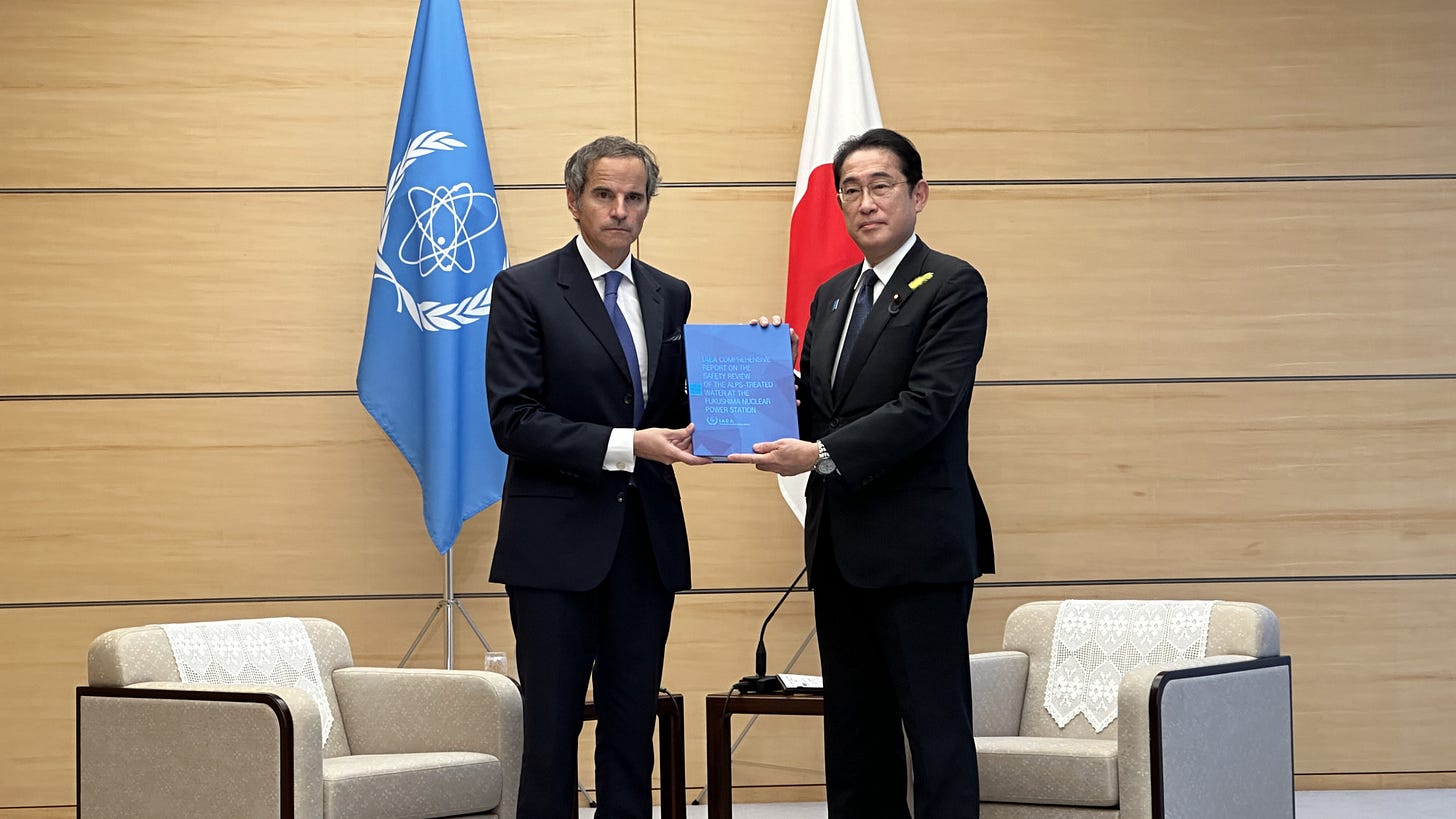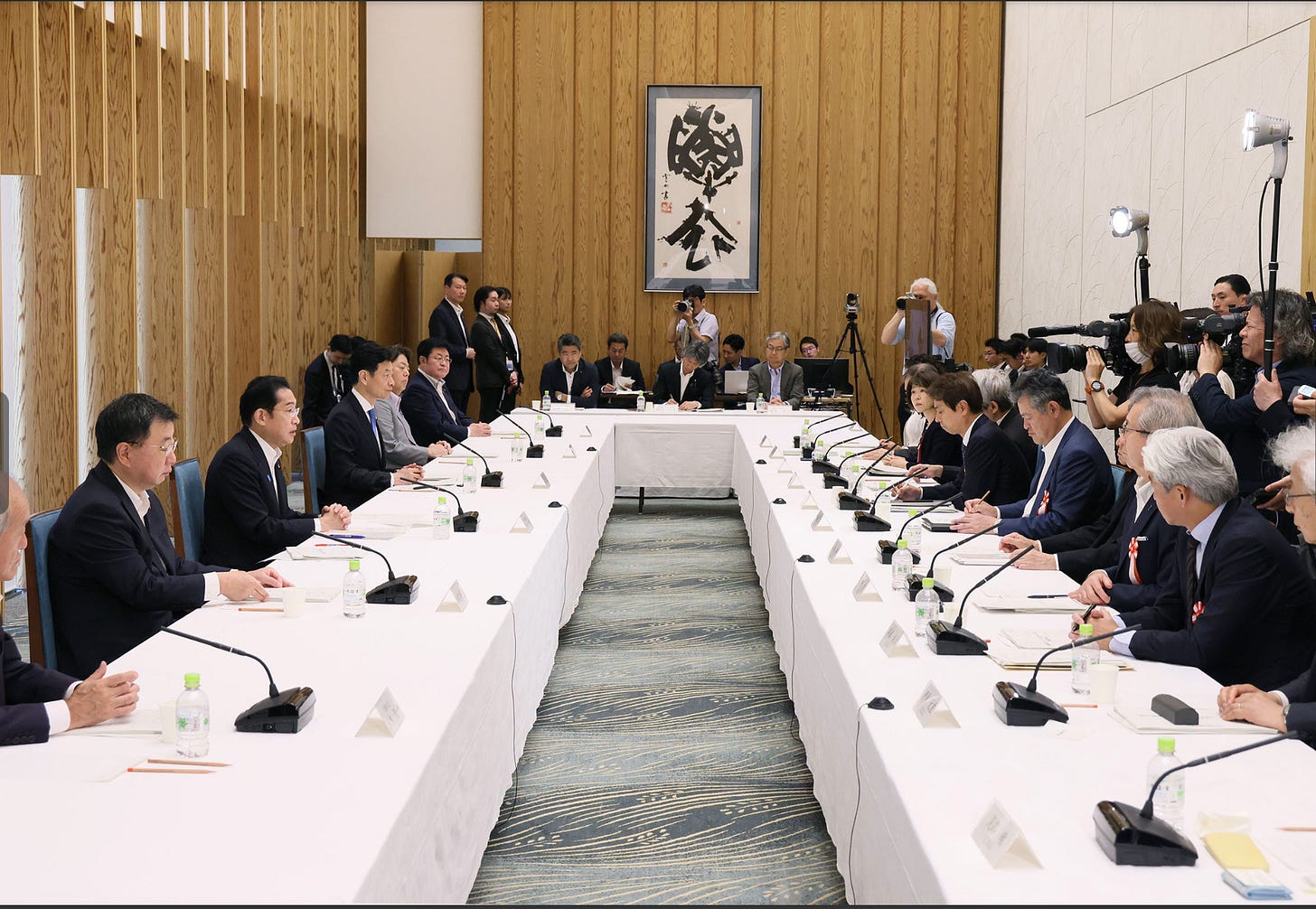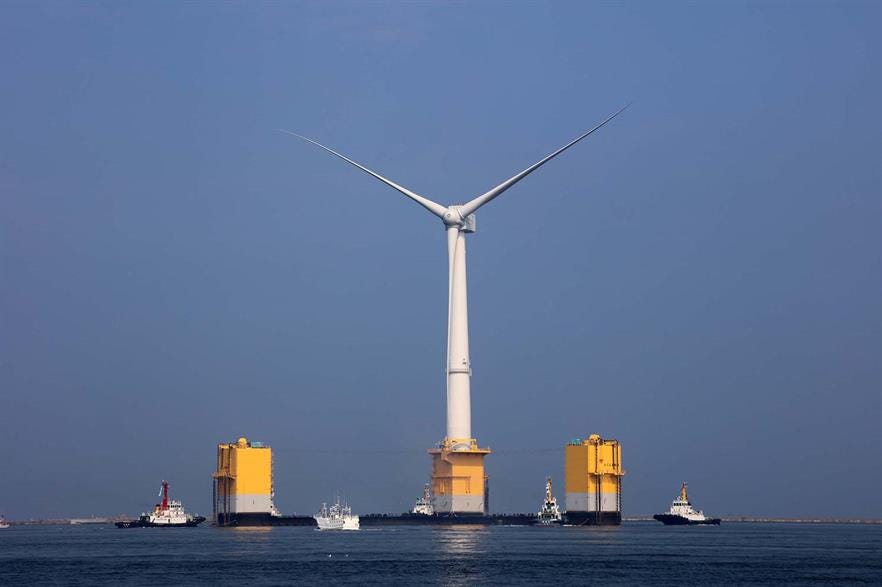Power Japan Newsletter - Sustainability Disclosure Standards, Nuclear Wastewater Release Gets Approval, GX Plan Shapes Up, and More
Hi all. This is the 3rd volume of the Power Japan Newsletter. In the last two weeks, major international sustainability disclosure standards were published, the Japanese government got one step closer to releasing wastewater from the Fukushima nuclear power plant, and got more specific on its Green Transformation strategy. Also, competition to develop Japan’s offshore wind is heating up, and a city near Tokyo launched a Climate Action Committee.
If you like this newsletter, the best thing you can do is to subscribe. I’d also be delighted if you repost it, comment on it, or simply “Like” it. If you have suggestions or questions, please comment at the bottom of the newsletter or send me a message.
On the Global Stage
The International Sustainability Standards Board (ISSB) finalized its sustainability disclosure standards

On June 26, the ISSB finalized standards for sustainability-related disclosures in capital markets. This is a big deal. A comprehensive sustainability disclosure standard will ask companies to report types of information that traditional financial reporting disregards - the company’s impacts on the environment, risks from climate-related events and regulatory changes, and much more. An internationally consistent standard helps companies communicate their sustainability performance across to investors globally. To put it in big picture terms, it's a tool to bring financial capitalism and sustainability into alignment.
Until now, corporate disclosure frameworks on climate change have been a wild west, crowded with a proliferating list of disclosure standards, guidelines, and ESG rating systems. The ISSB claims that with its standards, investors will be able to more easily assess and compare companies’ sustainability efforts and climate impacts. Based on the financial market concept of "companies disclose, markets evaluate," the goal is to push companies to establish a strategy for a decarbonized society through investor pressure and dialogue.
The ISSB spent more than 18 months developing this new standard based on consultations with a host of international organizations (G20, Task Force on Climate-Related Financial Disclosures, Sustainability Accounting Standards Board, International Organization of Securities Commissions) as well as business and investment industry leaders. The resulting standards are suitable application around the world. As such, the standards have garnered wide acclaim.
The standards consist of "S1" and "S2". S1 providing a set of disclosure requirements designed to enable companies to communicate to investors about the sustainability-related risks and opportunities they face over the short, medium, and long term. S2 sets out specific climate-related disclosures and is designed to be used with S1. Companies are encouraged to provide these disclosures in the same reporting package as their financial statements.
Companies will be required to disclose a variety of information: ISSB standards will require listed companies to disclose not only their own GHG emissions, but also those of their entire supply chain, including suppliers, financial risks from disasters or regulatory changes, and climate change-related information. That’s in addition to information about their governance, strategy, risk management and performance along with industry-specific information.
The standards will be effective starting January 2024. Investors will begin to see information in 2025 for companies that apply the standards during their 2024 reporting cycle. Specific disclosure requirements will be set by each country.
Japan is set to be one of the early adopters, along with Australia, Canada, Hong Kong, Malaysia, New Zealand, Nigeria, Singapore and the UK.
Japan is considering implementing standards: The Sustainability Standards Board of Japan (SSBJ), a private-sector organization, will take the lead and publish a draft based on the ISSB's standards by the end of March 2024, with plans to finalize the draft by the end of March 2025. Japanese companies are expected to disclose information based on those standards starting with their annual securities reports for the fiscal year ending March 31, 2026.
Multiple Japanese companies ahead of the curve: A number of Japanese companies are taking steps to enhance their information disclosure ahead of others. Ricoh, an electronics company, already discloses scenarios of climate change impacts, showing how profits will be hit. Hitachi Construction Machinery has been disclosing its greenhouse gas emissions since 2009, including Scope 3 emissions.
In and Around Japan
The IAEA OKs the Government’s Plans to Release Treated Water from the Fukushima Nuclear Plant

On July 4, International Atomic Energy Agency (IAEA) Director General Rafael Grossi visited Japan to hand Prime Minister Kishida a report on the safety review of the water used to cool nuclear reactors at the Fukushima Daiichi Nuclear Power Plant.
Since the accident at the Fukushima Daiichi Nuclear Power Plant in 2011, the reactors are still being cooled today, and the water used to cool the reactors is being stored in more than 1,000 tanks on the Fukushima nuclear plant site. Before it’s stored, the water is put through ALPS (Advanced Liquid Processing System) to remove as much of the radioactivity as possible.
In April 2021, the government decided that releasing the wastewater into the Pacific Ocean is the best course of action, arguing that the level of radioactive contaminants remaining in the water is well below regulatory limits, and that the storage space on the Fukushima site is quickly running out.
The two main conclusions of the IAEA's 140-page report were:
Consistent with international standards: The approach to the offshore discharge of ALPS process water and related activities by TEPCO, the Japanese Nuclear Regulatory Commission, and the Government of Japan are consistent with relevant international safety standards.
Negligible impact on health & environment: The radiation impact on humans and the environment from TEPCO's current plans for the offshore discharge of ALPS water is negligible.
The IAEA’s approval bolsters the scientific basis for the government's and TEPCO's plan to begin discharging the water sometime this summer.
What is ALPS-treated water anyway? As carefully explained by a group of scientists is a good guide:
After cooling the reactors, the water is repeatedly passed through the ALPS purification process until the majority of the radioactive materials are removed.
The main radioactive material remaining after the process is tritium, which is a radioactive form of hydrogen. Tritium is difficult to remove from water (H2O), and there is no technology to remove trace amounts of tritium from the volume of water on the Fukushima site.
It’s unrealistic to keep storing the water of such a large volume, since the half-life of tritium means it takes 100 years for its radioactivity to become negligible.
Yet releasing the water into the Pacific is safe because the amount of tritium in the Fukushima wastewater is much lower than the amount of tritium already in the Pacific Ocean, and because Japanese authority will be releasing tiny amounts of it each year.
Yet, there’s been vocal resistance both domestically and internationally to Japan’s plan.
The Pacific Islands Forum, a regional group headed by Cook Islands former Prime Minister Henry Puna, has spoken out against the release plan. China, South Korea, and Pacific island nations, have also been critical.
Domestically, the most notable opposition comes from the fishing industry, particularly in and around the Fukushima Prefecture. These groups cites several concerns, including potential impact of the water on human health, fears of reputational damage to the sale of their fish, and that policymakers have not been attentive to the opinions of local fishing groups. In June, the Sōma Futaba Fishery Cooperative Association in Fukushima Prefecture handed a letter to the Ministry of Economy, Trade and Industry to express the voice of its members. The government and TEPCO have repeatedly emphasized that "[no] action will be taken without the understanding of all concerned parties.” This reassurance has so far failed to ameliorate fishermen's anxiety.
The Government is Firming Up Its GX Strategy

On June 27, the Prime Minister’s Office held the 6th "Green Transformation (GX) Implementation Conference.” The conference was convened to give concrete shape to the GX Basic Policy, put forth by the Kishida administration in February 2023. The conference consisted of 13 members, drawn from academia, energy industry, labor and consumer advocacy groups, finance, and think tanks.
While the agenda was extensive, it broadly focused on 4 items:
The “GX Economic Transition Bonds” worth 20 trillion yen (USD 139 billion) to be issued this year. This bond will be the first government-issued transition bond and its aim is to de-risk private-sector investment in decarbonization technologies over the next 10 years.
Emissions Trading System (ETS) to begin in 2026. The government established the “GX League,” a consortium of nearly 700 Japanese firms that voluntarily participate in a carbon pricing scheme. Policymakers envision the next stage in the country’s carbon pricing trajectory to be the ETS. Finally, by 2033, they hope to introduce a carbon auction scheme.
Target industries for GX investment. Revenues from the GX Economic Transition Bonds and the carbon pricing system will be used as part of public-private investments worth 150 trillion yen (USD 1.04 trillion) in what the government considers essential decarbonization technologies over the next 10 years. Examples of projects that meet the basic principles of GX investment include storage battery facilities, the automotive industry, renewable energy, housing and buildings, hydrogen and ammonia, and CO2 capture and storage (CCS), etc.
Japan-centric multilateralism. Japanese government and industry plans to lead net-zero efforts in Asia by providing low-carbon energy infrastructure and transition finance. The METI-led Asia Zero-Emission Community will be the key multilateral institution for this effort.
Prime Minister Kishida expressed the boldness and urgency of the strategy, saying, "GX is the foremost issue that cannot be postponed, which also plays a major role in economic security, and I hope that the relevant ministries and agencies will work together to tackle the concrete implementation of unprecedented and bold policies.”
Still, challenges remain. Although the conference materials certainly mention the need to reduce domestic fossil fuels and greenhouse gas emissions, repeated mentions of “growth-orientation,” enhancing the profitability of domestic firms, and industrial competitiveness catches the eye. The government is trying to meet a two-fold goal of decarbonization and industrial competitiveness, but one can’t escape the feeling that the latter goal is weighed more heavily. This lack of urgency may be part of the reason why decarbonization investments in Japan are lower than in other developed countries.
For those of us who have been following the GX Plan over the last year and a half, the primary problem with the plan hasn’t gone away — the government is doubling down on its claim that Japan’s advanced fossil fuel technologies (hydrogen and ammonia co-firing, carbon capture and storage) are effective decarbonization strategies. I fear that the absence of serious domestic opposition to the GX plan, as it moves through legislation and concrete policy implementation, will lock-in false solutions and GHG emissions for decades to come.
~20 companies bid for large-scale offshore wind
Around 20 companies, including Itochu and Tokyo Gas, are looking to put in bids to develop offshore wind farms, according to Nikkei. The projects will be located in Nagasaki, Niigata, and Akita, and will have a total output of approximately 1.8 gigawatts, the equivalent of 2 nuclear reactors. Competition over offshore wind power, the star of Japan's renewable energy strategy, is intensifying.
This is the second round of bids. The first being in December 2021, when a consortium of Mitsubishi Corporation companies was selected for all three sea areas. Price was an important factor in the decision, and the upper limit of the bid price was set at 19 yen per kW-hr except off the coast of Nagasaki Prefecture, which was 10 yen lower than the first round.
Fixed-bottom in Niigata. All of the offshore wind farms in the four areas will be fixed-bottom rather than floating, with the largest number of bids expected in the shores off of Murakami and Tainai — two cities in Niigata Prefecture.
Goal of 10 gigawatts. The government has set a goal of introducing 10 gigawatts of offshore wind power by 30 years, equivalent to 10 nuclear power plants. Large-scale development through public solicitation is an important initiative toward making renewable energy the main source of power.
The Atsugi Climate Action Committee was launched

The Climate Action Committee was launched in Atsugi City in Kanagawa Prefecture. The Committee is a way to involve Atsugi residents to chart a path to decarbonize and revitalize the city. The first meeting was held on June 18 with 54 randomly selected participants, and included an orientation and a lecture on the causes and effects of climate change.
Atsugi has been proactive. Atsugi City has already created a "2050 Carbon Neutral Roadmap," which outlines a path for the government, businesses, and citizens to work together to low the city’s emissions.
In-depth lectures. At the first meeting on the 18th, Tokyo University climate scientist Emori Seita gave a lecture on the causes, effects, and solutions to climate change based on the IPCC Synthesis Report. The second lecture by Watanabe Atsugi of the Institute for Global Environmental Strategies covered what individuals and households can do to reduce their carbon footprint in the areas of mobility, energy consumption, food, products purchases, and leisure, and discussed the merits of each measure in an hour-long group work session.
The Committee’s deliverable will be a "Citizens Action Plan for Decarbonization" and have it reflected in the city administration as an official action plan.
If you recall the first issue of the Power Japan Newsletter, Hakuba Village in Nagano Prefecture prepared a "Zero Carbon Action Plan.” The Atsugi Climate Action Committee is one of the many climate citizens' conferences held around Japan. From the selection of participants, decision-making methods, and activities to build trust among participants, the Climate Action Committee seem to me to come as close as anything else to the very ideal of democracy.
That’s it for this week. Did you like what you read? Subscribe, like, and share the Power Japan Newsletter.
If you have suggestions on news pieces that would be a good fit for this newsletter, don’t hesitate to message me or comment below.
The views expressed on this newsletter/blog are mine alone and do not necessarily reflect the views of my employer.




